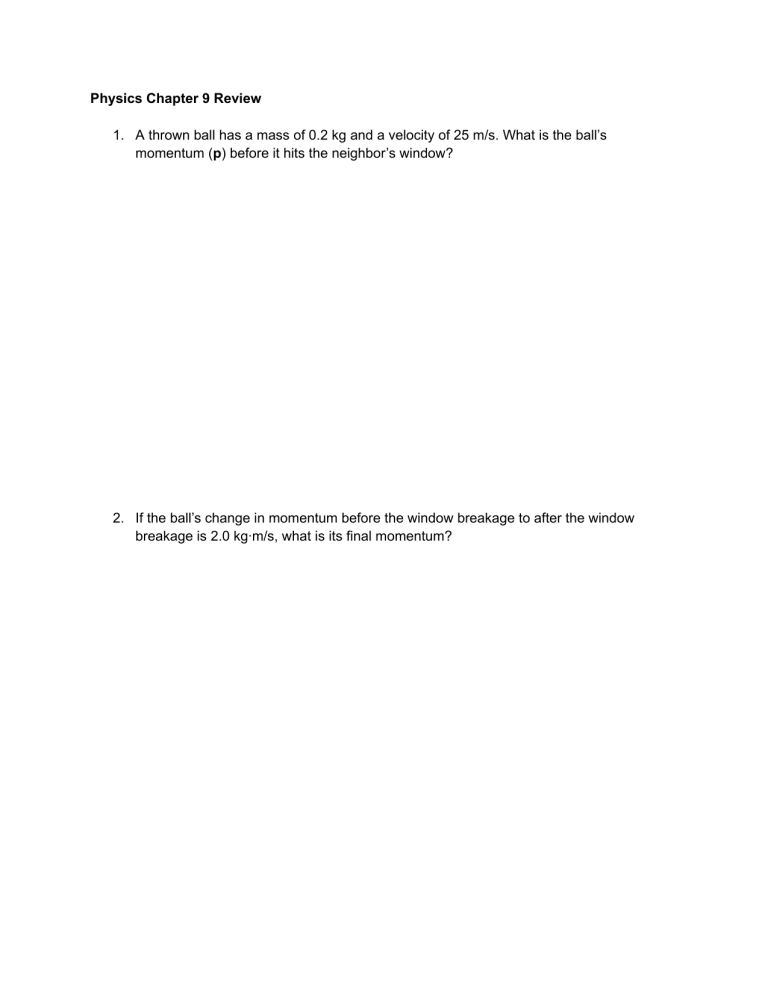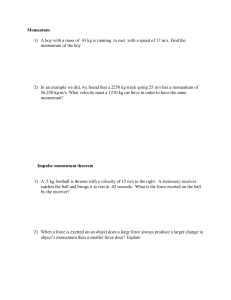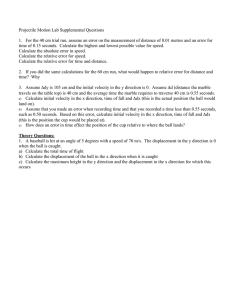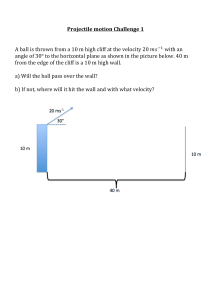
Physics Chapter 9 Review 1. A thrown ball has a mass of 0.2 kg and a velocity of 25 m/s. What is the ball’s momentum (p) before it hits the neighbor’s window? 2. If the ball’s change in momentum before the window breakage to after the window breakage is 2.0 kg∙m/s, what is its final momentum? 3. What is the ball’s final velocity? 4. A 2000-kg car traveling 20 m/s can be stopped in 20 s by applying the brakes. What is the impulse exerted on the vehicle? What is the average force exerted on the vehicle in the stop? 5. A bicyclist applies the brakes and slows the motion of the wheels. The angular momentum of each wheel then decreases from 7.0 kg∙m2/s to 3.5 kg∙m2/s over a period of 5.0 s. What is the angular impulse on each wheel? 6. A force of 16 N exerted against a rock with an impulse of 0.8 kg∙m/s causes the rock to fly off the ground with a speed of 4.0 m/s. What is the mass of the rock? 7. A rocket with a thrust of 35 N is fired to change a 72000-kg spacecraft’s speed by 63 cm/s. For how long should it be fired? 8. A professional bowler launches a 3.6-kg bowling ball down the lane with a torque of 50 N∙m. If the radius of the ball is 0.12 m, how much time does it take for the ball to reach a velocity of 8.1 m/s needed to effectively knock down the most pins? 9. A 0.145-kg baseball is pitched at 42 m/s. The batter then hits the ball horizontally toward the pitcher at 58 m/s. Find the change in the momentum of the ball. If the ball and the bat are in contact for 4.6 x 10-4 s, what is the average force during the contact? 10. A hockey puck has a mass of 0.1115 kg and strikes the pole of the net at 37 m/s. It bounces off in the opposite direction at 25 m/s. What is the impulse on the puck? If the collision takes 5.0 x 10-4 s, what is the average force on the puck? 11. A 5500-kg freight truck accelerates from 4.2 m/s to 7.8 m/s in 15.0 s by the application of a constant force. What change in momentum occurs? How large is the force that is exerted? 12. A car moving at 10.0 m/s crashes into a barrier and stops in 0.050 s. There is a 20.0-kg child in the car. Assume that the child’s velocity is changed by the same amount as that of the car, and in the same time period. What is the impulse needed to stop the child? What is the average force on the child? What is the approximate mass of an object whose weight equals the force on the child? Could you lift such a weight with your arm? 13. A 12.0-g rubber bullet travels at a forward velocity of 150 m/s, hits a stationary 8.5-kg concrete block resting on a frictionless surface, and ricochets in the opposite direction with a velocity of -110 m/s. How fast will the concrete block be moving? 14. A blue marble with a mass of 5.0 g moves at a speed of 20.0 cm/s. It collides with a red marble with a mass of 10.0 g, moving at 10.0 cm/s in the same direction. After the collision, the blue marble continues with a speed of 8.0 cm/s in the same direction. What are each of the marbles’ momentums before the collision? What is the blue marble’s momentum after the collision? What is the red marble’s momentum after the collision? What is the speed of the red marble after the collision? 15. A 50.0-g projectile is launched with a horizontal velocity of 647 m/s from a 4.65-kg launcher moving in the same direction at 2.00 m/s. What is the launcher’s velocity after the launch? 16. A 60.0-kg dancer leaps 0.32 m high. With what momentum does he reach the ground? What impulse is needed to stop the dancer?






